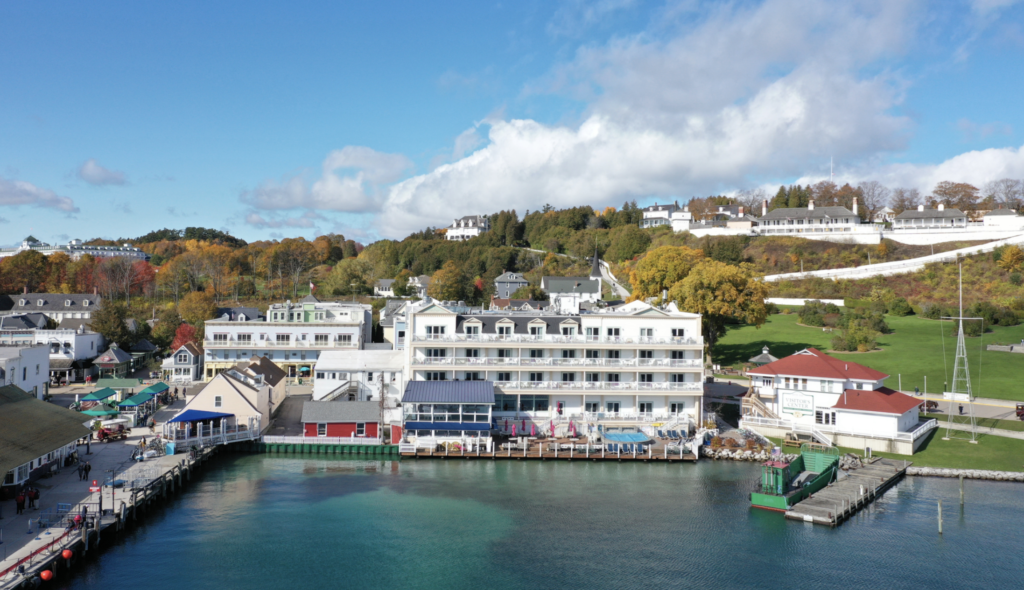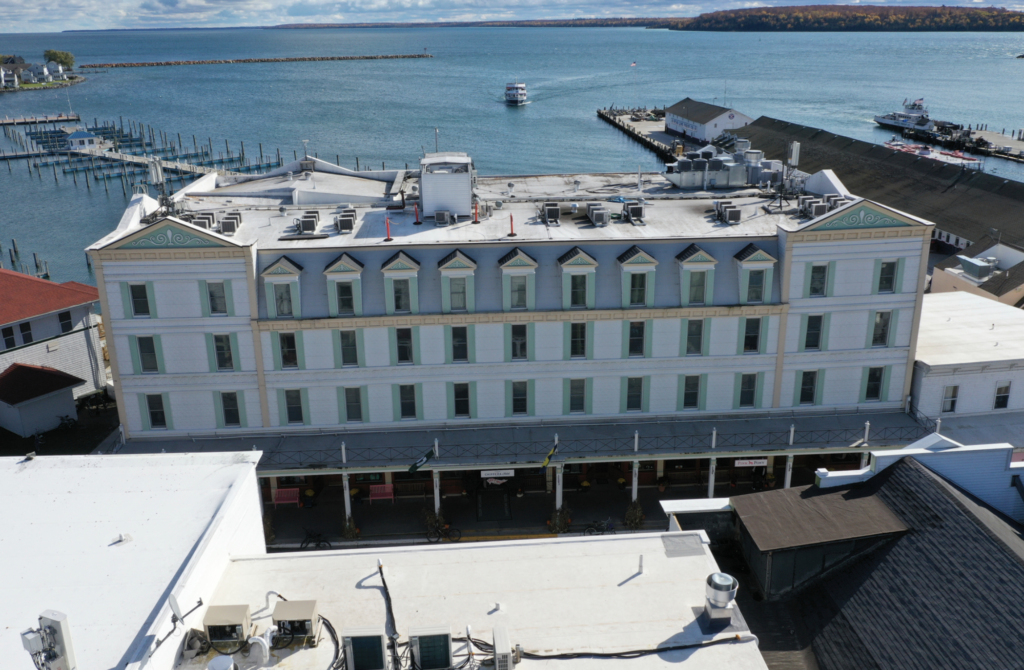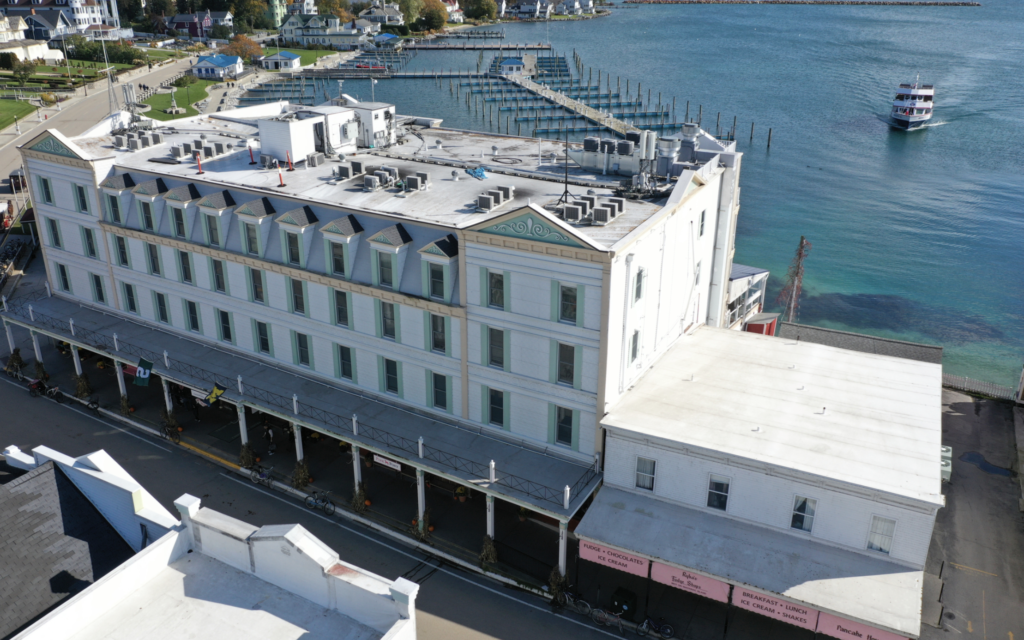
Mackinac Island, Michigan, is a community that takes you back to the older, golden days of the past. There are no vehicles allowed on the island so visitors and residents must use horse-drawn carriages, walk or ride bicycles to get where they want to go. The only access to the island is via a ferry and that shuts down in the winter when ice forms in the channel.
With no vehicles and limited access to the island, imagine how challenging it would be to re-roof one of the island’s waterfront hotels — not to mention doing it as winter was right around the corner. That is the challenge that Traverse City, Michigan-based Bloxsom Roofing took on when they were hired to re-roof the Chippewa Hotel.
The historic hotel was built in 1902 and had several renovations over the years. Its existing 13,000 square-foot EPDM roof was failing, and the owners called Craig Bloxsom at Bloxsom Roofing for assistance. “We received a call in the fall of 2018 asking us to look at the project, but it was too late in the year and we didn’t have resources available to take on the work,” explains Bloxsom. “They called back after the first of the year because they still had not had their roof looked at and they wanted a price for re-roofing it.”
It was mid-March when Bloxsom visited the island. With ferry service unavailable due to ice, he had to take a small plane to get there. He was met at the airport by a horse and carriage that took him to the hotel.

His first impression when he saw the jobsite was not good. He noted that AT&T had two transmission towers that were non-penetrating, but each took up a 12-foot-by-12-foot area and had a large trunk line running across the roof between the towers. There were also two very large HVAC units along with two shed-like structures in the center of the roof that each had a 10-foot-by-10-foot footprint. This left Bloxsom wondering how they were going to get underneath the structures. “You couldn’t go more than three or four feet in any direction without there being some penetration,” he says.
Beyond the penetration challenges, Bloxsom was worried about logistics. The roof was 50 feet high, and with no vehicles allowed on the island and restrictions on other equipment, he wondered how he would be able to get the materials and equipment onto the roof.
After inspecting the existing EPDM membrane that was fully adhered over cover board, Bloxsom determined that he would be able to leave it in place, eliminating the challenge of removing the old roof and getting it off the island. Wanting to make sure that the new roof would provide strong protection from the elements and from all of the inevitable roof traffic, Bloxsom recommended an IB Roof 80-mil PVC Fleeceback system that would be mechanically attached over the existing roof. Because the roof was vented, with open air space underneath, there was no need for insulation.
Bloxsom said that in addition to IB Roof’s strong track record of performance, another reason he thought that the IB Roof PVC membrane was more ideal for the job is because it comes in 6-foot-wide rolls. “Most manufacturers have 10 or 12-foot rolls and between having to lift the rolls to the roof height and all the penetrations on the roof, the six-foot rolls would be much easier for my crew to work with,” explains Bloxsom.

The owner liked the proposal and hired Bloxsom Roofing to perform the work. With work set to begin in November, Bloxsom began the challenge of figuring out the logistics of the project. The property owner was able to find an apartment for the crew that was located just across the street. “It was kind of like a bunkhouse for our guys,” Bloxsom notes. “It had a kitchen for them to make food since most of the restaurants on the island were closed for the season. I became a shopper, making weekly trips to the island to deliver food and supplies for them.”
Now that the crew had quarters, Bloxsom needed to worry about how to get the equipment and materials to the island and up onto the roof. He found a company that was dedicated to getting freight over to the island and they were able to ship the job trailer to the island and leave it parked at their dock. The membrane and job materials were transported to the hotel by a team of horses.
The property owner had a Skytrak lift that would go as high as 80 feet, so crews were able to use it for much of the roof loading, but the lift wouldn’t be able to handle the weight of the membrane rolls and the generator. Fortunately, there was one crane on the island, and they were able to arrange to use it to get the membrane and the generator loaded onto the roof.
Once the job began it was not all smooth sailing. The crews discovered that someone had cut a sort of trench into the roof to direct water at either end where two large scuppers were located. “Every direction you turned there seemed to be a challenge,” says Bloxsom. “The trenches were 3 to 4 feet deep, 10 inches wide and about 12 feet long. We ended up removing the scuppers and installing roof drains.”
Getting underneath the HVAC units and shed-like structures was challenging for the crew as well. “We found that the HVAC units had roof curbs, so we were able to drill through the curbs and raise the units using floor jacks,” explains Bloxsom.
Cold weather comes early in northern Michigan and there were a few days of sub-zero temperatures not to mention the 10-inches of snow that fell the week before they were set to finish. Fortunately, the crews had installed a good portion of the roof before the snow and were able to shovel the snow over to the finished parts in order to complete the installation.
The Chippewa Hotel is now watertight, with a brand-new roof backed by a 15-year IB Roof Total System Warranty.
TEAM
Roofing Contractor: Bloxsom Roofing, Traverse City, Michigan, www.bloxsomroofing.com
MATERIALS
Low-Slope Roof System: 80-mil PVC Fleeceback, IB Roof, www.IBroof.com



Be the first to comment on "Horsepower Has a New Meaning on Historic Roofing Project"